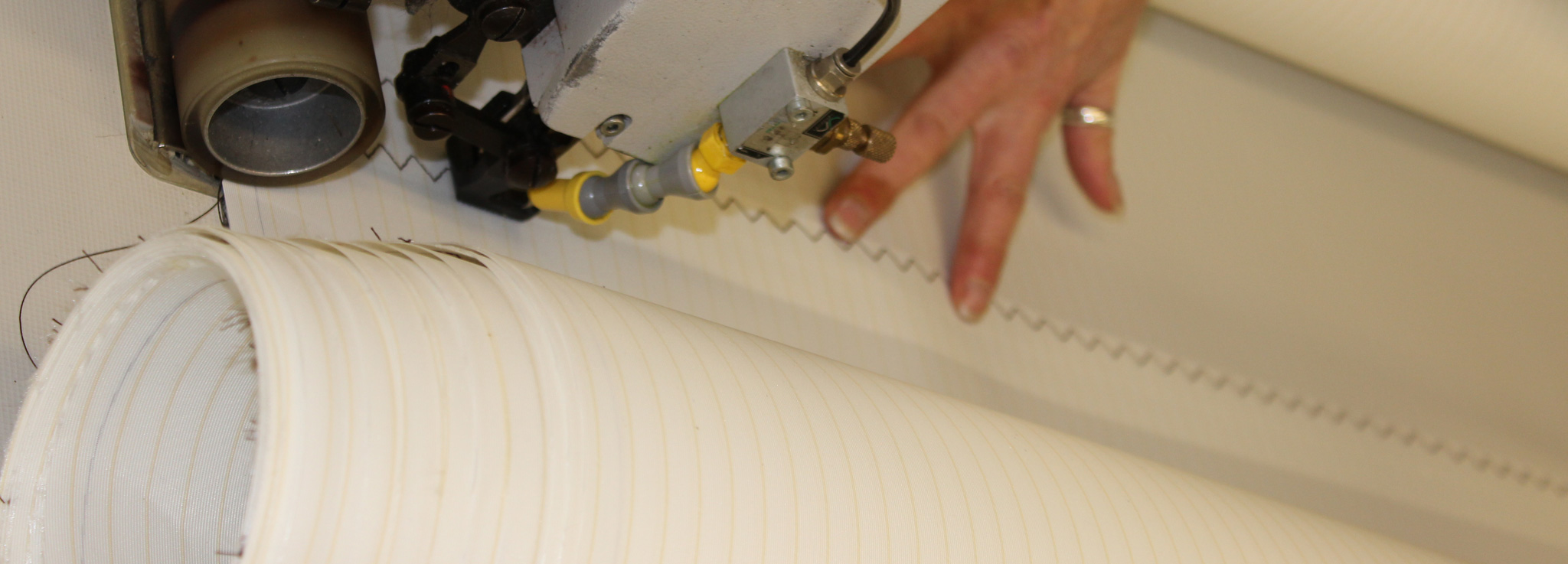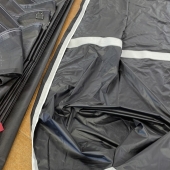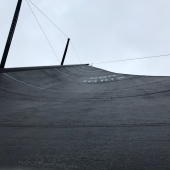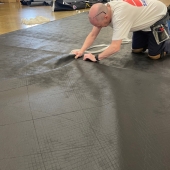
Materials
There are many fabrics available to the sailmaker. Here at Sanders, we only use the best as we rely entirely on word of mouth for our orders. This is why you will never see medium tenacity, ‘boat show’ quality fabric in our loft – let alone in our sails.
Every member of our team takes huge pride in what we manufacture, so why settle for anything less than the best? Please contact us for our recommendation of what you need for your sailing application, but here is a brief list of some of the options we most commonly use.
WOVENS:
DACRON
The first Dacron (polyester) was developed in the 1950’s and this is still the most popular material for sails today. The quality of the Dacron is governed by the tenacity of the yarn used and the tightness of the weave. Cheaper Dacron’s incorporate large denier, medium tenacity yarns which results in excessive crimp. The better-quality Dacron’s use a finer denier, high tenacity yarn and considerably more of them. This means that it takes far longer to ‘load the beam’ prior to weaving and far longer to weave the cloth. You may be surprised to hear that a good quality Dacron costs twice as much as the cheaper styles, which is why ‘boat show sailmakers’ will normally only use the later. However; a good quality Dacron will last far longer and perform far better, making the initial increase in cost a worthwhile expense.
In the first 40 years of our business, we almost exclusively used Hood Dacron for our cruising sails which was woven on old fashioned looms in Ireland. Unfortunately; this facility has now closed down, which has forced us to investigate the market for the best quality. This was an enlightening experience, because we have not only discovered how cheap some fabrics are, but also how poorly they perform. After years of testing across several styles, from all manufactures – we were quickly able to eliminate a large quantity as being “not good enough for Sanders” and are now very proud to offer the following:
A) Crosscut Dacron:
b) Best Quality: Dimension Polyant AP & SF
c) Classic Quality: Contender AP
B) Radial Dacron:
b) Racing Quality: Dimension Polyant Pro Radial
N.B. The racing quality fabrics are also suitable for performance cruising.
VECTRON
Vectron used to be exclusively manufactured by Hood textiles in Ireland, but since their closure, three other companies have started to produce it. Like our Dacron sailcloth’s, we have put months of research and testing into the new alternatives and we are delighted with what we can now offer. Vectron combines the best properties of two very talented fibres: high strength polyester meets low stretch and high modulus Vectran. The result of this unique fusion is a tightly woven fabric that is both incredibly stable and easy to handle. Dimension Polyant’s Vectron is our cloth of choice in this range, but we also offer Contender’s Pro Vectran, which offers a different range of weights at a lesser cost.
b) Contender Fibercon Pro Vectran
N.B. The Contender Pro Vectran range has a slightly softer finish to that of Dimension Polyant’s Vectron.
HYDRANET RADIAL
Dimension Polyant’s Hydra Net Radial is a woven fabric that benefits from an extremely high share of Ultra-PE fibres in the warp direction providing a low stretch sail cloth with superb durability. Whilst exceeding the specification of other woven options, this sailcloth reaches radial design targets, which until recently were only possible with laminates. Now they can be put into practice with Hydra Net Radial because of its tightly woven polyester base with a ripstop of Ultra-PE. An additional benefit of this construction is that it is based on a breathable platform, where the less damp environment gives mildew growth a much smaller chance of developing. This is very popular in our Ocean sailors – wanting to optimise all of the benefits listed above.
LAMINATES
The problem with woven materials is that due to the weaving process, the yarns are ‘crimped’, which means that there is a certain amount of stretch inherent in the construction. Laminating eliminates this crimp and the film used either side of the scrim provides good bias support. Laminating reduces the amount of the yarn content required, which results in a lighter sailcloth with less stretch. Racing sails take advantage of this reduction in weight, so most racing laminates are what is known as ‘film on film’; in other words, shiny on both sides. Although this weight reduction is an advantage to cruising sailors too, the durability reduction isn’t. For this reason, cruising laminates have a layer of light weight taffeta glued to each side of the fabric. This taffeta increases the bulk of the cloth, which in turn increases the durability.
RACING LAMINATES:
Sanders offer 4 styles of racing laminate with a variety of yarn and taffeta options. These are determined by the racing you plan to do – be it local inshore club racing, up to offshore multiple day RORC events.
A. Grand Prix Laminate (GPL)
Dimension Polyant’s GPL was the first laminated sailcloth line to capture the strength of high-performance carbon. This cloth benefits from high strength carbon warp sheet fibres, a super rugged Technora base and Technora X-Ply. As a pioneering racing fabric, GPL keeps impressing with incredible resistance to flex, elongation and degradation from UV. If you do not wish to compromise on high performance, this composite sail cloth is the one for you. There are two options available in this racing range:
a. GPL Graph X (film on film)
b. GPL Lite Skin (taffeta on taffeta)
B. Carbon Sport Black (CS)
The Carbon Sport line is the result of meticulous reconfiguration of the race proven GPL range. Substituting a rugged black polyester in the base warp scrim, CS provides an economical, high-performance product with exceptional flex and impact durability. By utilising the same Carbon warp insert and Technora black X-Ply as the GPL range, CS delivers incredible value with superior shape holding characteristics. The film-on-film option is held together in a black adhesive giving a modern opaque appearance.
a. CS Black (film on film)
b. CS Lite Skin (taffeta on taffeta)
C. Aramid Sport (AS)
If you are a keen club racer, looking for the perfect combination between performance and longevity – then the Aramid Sport sail cloth could be for you. Based on Aramid load bearing fibres and manufactured with Dimension Polyant’s patented X-Ply technology, this is a fantastic addition to our racing sail cloth range. This only comes in the ‘lite skin’ taffeta range.
a. AS Lite Skin (taffeta on taffeta)
D. Racing Membrane
Membrane sails are custom made laminates. The yarns are individually positioned to align the loads in the sail. This method of construction is the most expensive, but also the most efficient. Sanders design the yarn maps of each sail, selecting the yarn type, denier and yarn count. There is an array of yarns available, including Carbon, Technora, Kevlar and Polyester.
CRUISING LAMINATES:
Sanders offer 3 primary cruising laminate options, on top of those mentioned in the racing segment. Made with both performance and durability in mind, these sails will give any cruising yacht a complete package for their upwind wardrobe.
A. Contender CDX Pro
CDX laminates are engineered for durability and cruising performance. Contender have designed the CDX Pro range around a series of sub-assemblies using different weights of taffeta’s and a 500-denier polyester cross-ply. The sub-assemblies are combined, one with another and a 6000-dpi polyester insertion to create a complimentary range of styles stepping up in weight and strength. This is a fabulously soft laminate, giving great ease of use and is offered in two styles.
a. CDX Pro Natural
b. CDX Pro Cool Grey
B. Dimension Polyant DCX Line
If you are an ambitious cruising sailor and looking for a low stretch material, then here is your straight forward answer: Dimension Polyant’s DCX cruising laminates have been developed with the aim of producing a high durability fabric. The film covering taffetas are robust and additionally coated with an UVM finish, adding two more desired features to the sail: it will be protected against harmful UV radiation and mildew growth gets reduced. This material tends to be a little more ‘stiffer’ and of harder handling that the comparative CDX Pro, and also comes in to forms:
a. DCX Natural
b. DCX Grey
C. Cruising Membrane
Membrane sails are custom made laminates. The yarns are individually positioned to align the loads in the sail. This method of construction is the most expensive, but also the most efficient. Sanders design the yarn maps of each sail, selecting the yarn type, denier and yarn count. There is an array of yarns available, including Carbon, Technora, Kevlar and Polyester. With our cruising laminates, we will apply a layer taffeta each side of the film providing strength and abrasion resistance.
Sanders Filmless Membranes (SFM)
We are incredibly proud to unveil Sanders Filmless Membranes (SFM), the latest evolution in sail membrane technology. Designed to deliver exceptional racing performance and unmatched ocean-going durability; SFM represents a groundbreaking advancement in sail construction.
Built with the finest materials available, without compromise, our filmless technology ensures unparalleled reliability, knowing that reliability is the foundation of what our customers demand. Developed in collaboration with Powerplast, SFM is engineered with a taffeta outer skin and no mylar film, providing exceptional adhesion strength within the composite.
Unrivalled Durability & Performance
The shape, stability and durability of our Filmless Membrane are so impressive that we confidently guarantee it against delamination for three years. Our Filmless Taffeta is treated with a UV-blocking resin and sanitised to resist mildew, ensuring longevity and reliability even in the harshest marine environments. At just 88 g/m², it is lighter than conventional taffetas, enhancing sail efficiency without compromising strength. Available in White, Black, Grey, and Dark Grey, it provides both aesthetic flexibility and superior protection.
Customisable Outer Skins & Reinforcement Fibres
To meet diverse sailing demands, we offer a range of outer skin materials:
- Film (available in 12, 19, and 23 microns / 0.5, 0.75, and 1 mil thickness).
- UV-blocking film – Ideal for extreme sun exposure.
- Taffeta (lightweight 60 g/m² with rip-stop net, heavyweight 100 g/m²) – UV-resistant with Titanium Oxide coating.
- Internal Taffeta – Enables glued (not sewn) construction, repels water, and provides a sleek, modern appearance.
Reinforcement fibres available include:
- Polyester
- Gold & Black Aramid
- Carbon
- UHMPE (Dyneema®)
Elevate Your Sailing Experience with Sanders Filmless Membranes, we set a new standard for innovation, durability, and performance. Whether you’re racing at the highest level or embarking on long-distance ocean cruising, SFM delivers uncompromising quality and reliability, because your sail should be as strong and resilient as the journey ahead.



